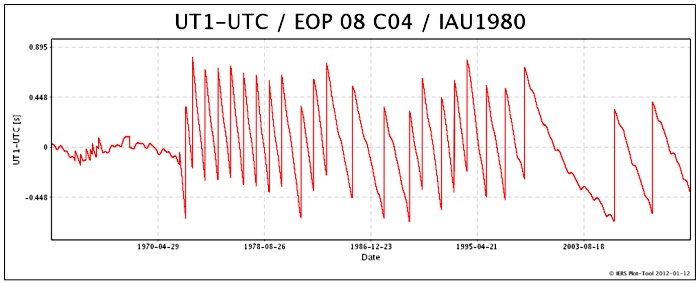On the abolishment of leap seconds
16 February 2012
The International Telecommunication Union Radiocommunication Assembly 2012 (RA-12) deliberated on whether to change the definition of the universally adopted time standard "Coordinated Universal Time (UTC)" to the effect that it would decouple from the astronomical time scale and adhere strictly to the atomic time scale, thus dispensing with the need to apply leap seconds. The RA-12 decided to defer the decision and conduct further studies to ensure that all the technical options would be fully addressed. The outcome of these studies would be referred to the next Radiocommunication Assembly and World Radiocommunication Conference scheduled for 2015.
As the Earth's rotation is uneven, the astronomical time scale based on the Earth's rotation differs slightly from the atomic time scale based on the frequency of atomic oscillations: At present, one second on the astronomical time scale is slightly longer than that on the atomic time scale. Since 1972, to reconcile the two time scales, the UTC follows the atomic time scales ordinarily, but with a leap second introduced when necessary such that the difference between the UTC and the astronomical time scale is kept to less than 0.9 second (Figure 1).
In case the definition of the UTC is changed to follow the atomic time scale entirely, it will no longer be necessary to introduce leap seconds. The time scale UTC will then become continuous and predictable, thus simplifying the development, testing and maintenance of computer and navigation systems and reducing the chance of incidents. However, without leap seconds, the time of astronomical phenomena in a day would drift against the UTC at a very slow rate. It is estimated that the time of sunrise and sunset would become two or three minutes later than now in a hundred years, and about half an hour later in seven hundred years. Thousands or tens of thousands of years from now, it may occur that the sun would rise at 6:00 p.m., and set at 6:00 a.m.
Before any resolution of the issue, leap seconds will continue to be introduced to the UTC from time to time. For example, a leap second would be introduced immediately before 8:00 a.m. on July 1 (Hong Kong Time) this year.

WOO Wang-chun
References:
[1] Press Release issued by the International Telecommunication Union
http://www.itu.int/net/pressoffice/press_releases/2012/03.aspx
[2] Press Release issued by the International Bureau of Weights and Measures (BIPM), prior to the discussions on RA-12
http://www.bipm.org/utils/en/pdf/Press_Release_UTC_13October.pdf
As the Earth's rotation is uneven, the astronomical time scale based on the Earth's rotation differs slightly from the atomic time scale based on the frequency of atomic oscillations: At present, one second on the astronomical time scale is slightly longer than that on the atomic time scale. Since 1972, to reconcile the two time scales, the UTC follows the atomic time scales ordinarily, but with a leap second introduced when necessary such that the difference between the UTC and the astronomical time scale is kept to less than 0.9 second (Figure 1).
In case the definition of the UTC is changed to follow the atomic time scale entirely, it will no longer be necessary to introduce leap seconds. The time scale UTC will then become continuous and predictable, thus simplifying the development, testing and maintenance of computer and navigation systems and reducing the chance of incidents. However, without leap seconds, the time of astronomical phenomena in a day would drift against the UTC at a very slow rate. It is estimated that the time of sunrise and sunset would become two or three minutes later than now in a hundred years, and about half an hour later in seven hundred years. Thousands or tens of thousands of years from now, it may occur that the sun would rise at 6:00 p.m., and set at 6:00 a.m.
Before any resolution of the issue, leap seconds will continue to be introduced to the UTC from time to time. For example, a leap second would be introduced immediately before 8:00 a.m. on July 1 (Hong Kong Time) this year.

| Figure 1. Difference of UT1, an astronomical time scale, and UTC, Coordinated Universal Time. From 1972 till now, leap seconds have been added 25 times. Leap seconds were not introduced at regular time intervals. They were introduced 6 times, 8 times and 2 times in the 1980s, 1990s and 2000s respectively. It thus can be seen that the rate of rotation of the Earth would speed up and slow down from time to time. Furthermore, the definition of UTC was changed in 1972, hence the difference before and after 1972 could not be directly compared. (Source of Chart: International Earth Rotation and Reference Systems Service) |
WOO Wang-chun
References:
[1] Press Release issued by the International Telecommunication Union
http://www.itu.int/net/pressoffice/press_releases/2012/03.aspx
[2] Press Release issued by the International Bureau of Weights and Measures (BIPM), prior to the discussions on RA-12
http://www.bipm.org/utils/en/pdf/Press_Release_UTC_13October.pdf